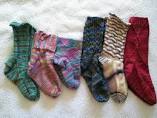GETTING RID OF A FEVER WITH COLD WET SOCKS!
 Here’s some food for thought: the next time your child (or you) experiences head congestion or spikes a fever, avoid reaching for the Over-The-Counter (OTC) medications. Instead, go into Little One’s sock drawer to stimulate his immune system!
Here’s some food for thought: the next time your child (or you) experiences head congestion or spikes a fever, avoid reaching for the Over-The-Counter (OTC) medications. Instead, go into Little One’s sock drawer to stimulate his immune system!
Spiking a fever is actually the body’s response to cooking out a pathogen. Instead of suppressing the fever with an OTC medication, consider helping the body move the fever through the body faster to do its necessary work in a more timely fashion. A fever is actually one of the body’s survival techniques. Many of the body’s immune cells works more effectively at a higher temperature. When medications such as fever reducers are used to lower a low grade fever, the result may actually delay healing.
The cold socks treatment is a long-standing naturopathic therapy for stimulating the immune system. It is effective in relieving the symptoms of many upper respiratory conditions such as head and chest colds, earaches, the flu, sore throats and even allergies. Relief is often seen within thirty minutes. If it is not, one can repeat the treatment while the patient remains covered and in bed. After four hours or usually by morning, the wet socks should be totally dry, the feet warm and the symptoms gone or much improved.
Here’s why the “Cold Sock” or “Wet Sock” treatment works:
Water that is below or above normal body temperature and applied to the body stimulates the “reflex arc” in which nerves send signals to muscles, blood vessels, lymph glands and internal organs. Body fluids are contained in a closed circuit, so whenever fluids in one part of the body are impacted, other parts of the body are also impacted.
Wet sock therapy, specifically cold damp socks, when applied to the feet, cause an initial blood vessel constriction response that is quickly followed by blood vessel dilation response. The body’s initial reaction to the cold socks is to increase heat production by dilating vessels to bring more blood flow to the feet. As blood flow volume to the feet increases, head and lymphatic tissues drain, internal organs decongest, and the immune system gets stimulated.
Here’s how it’s done:
Step 1: Soak the foot part of a pair of 100% cotton socks in very cold water and wring them out thoroughly.
Step 2: Put the patient’s feet into a basin or bathtub of hot water, as hot as tolerable without burning. Have the bath deep enough to cover the ankles. Have the patient sit on a chair or the edge of the tub, and keep the rest of the body warm. Soak the feet for about 5 to 8 minutes until they are hot and pink.
Step 3: Remove the feet from the hot water and pat then dry with a towel.
Step 4: Immediately put on the cold wet cotton socks, and then a pair of dry wool socks over those. The patient should be covered and kept warm.
Step 5: Patient should go directly to bed, keeping the feet covered throughout the night. This therapy is not effective if the feet are uncovered, or if the patient walks around or sits in a chair uncovered. This home remedy works through a process of hemodynamics – by moving the blood to a specific area of the body, in this case the feet. When the blood is drawn away from the head to warm the feet, pressure in the head is relieved and the symptoms of the illness may disappear. The Cold Sock Treatment typically induces sleep almost immediately. This treatment may actually boost the immune system, moving the patient through the illness faster.
Who shouldn’t used the Cold, Wet Sock Treatment?
People with diabetes, Raynaud’s syndrome, arterial insufficiency, or advanced intermittent claudication should use caution and consult with a doctor before starting the wet sock treatment.
When is it best to call your doctor?
The topic of fever degree for various ages is a point of disagreement among many professionals. The Cold Sock Treatment is a home remedy intended for low-grade fevers or head congestion. If the Cold Sock Treatment does not reduce the fever; if the fever is not accompanied by other symptoms of cold or flu; if the fever is accompanied by abdominal pain or digestive concerns, breathing difficulties, chest pain, confusion, leg swelling, rash, red or hot swollen skin, seizures, severe headache, and/or urination pain; or if the fever gets worse, consult a qualified healthcare professional immediately.
This article is not intended as a substitute for care provided by a qualified healthcare professional.
AUTHOR
Jennette Cable, ND, CTN, CCH, ST is in private practice as a traditional naturopath, certified classical homeopath, and sound therapist. She is the founder and director of Creative Care & Wellness Center, a holistic wellness facility that celebrates the synergy between the creative expressive arts and holistic health through a creative array of classes, programs, and practitioners offering various holistic healing modalities.



